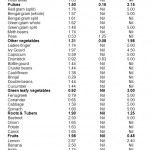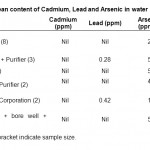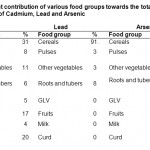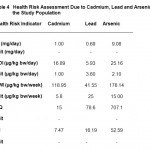Heavy Metal Content of Foods and Health Risk Assessment in the Study Population of Vadodara
Suneeta Chandorkar1 * and Prachi Deota1
1
Department of Foods and Nutrition,
The M. S. University of Baroda,
Vadodara,
390002
India
DOI: http://dx.doi.org/10.12944/CWE.8.2.15
Copy the following to cite this article:
Chandorkar S, Deota P. Heavy Metal Content of Foods and Health Risk Assessment in the Study Population of Vadodara. Curr World Environ 2013;8(2) DOI:http://dx.doi.org/10.12944/CWE.8.2.15
Copy the following to cite this URL:
Chandorkar S, Deota P. Heavy Metal Content of Foods and Health Risk Assessment in the Study Population of Vadodara. Curr World Environ 2013;8(2). Available from: http://www.cwejournal.org/?p=4762
Download article (pdf)
Citation Manager
Publish History
Select type of program for download
| Endnote EndNote format (Mac & Win) | |
| Reference Manager Ris format (Win only) | |
| Procite Ris format (Win only) | |
| Medlars Format | |
| RefWorks Format RefWorks format (Mac & Win) | |
| BibTex Format BibTex format (Mac & Win) |
Article Publishing History
| Received: | 2013-05-21 |
|---|---|
| Accepted: | 2013-07-28 |
Introduction
Heavy metals find their entry into food from natural sources like soil, air and water through wastewater irrigation, solid waste disposal, mining, smelting, sludge applications, vehicular exhaust, fertilizers, fungicides and industrial activities.1 Muhammed et al., 2008).2 Radwan and Salama, 2006). Consumption of food crops contaminated with heavy metals is a major food chain route for human exposure3 Khan et al., 2008). The absorption of heavy metals in the system varies to certain extent depending on various factors. The gastrointestinal absorption of Cadmium was double in women with low body iron stores compared to the control group. There is evidence indicating increased fractional absorption of Lead with respect to chronic ingestion of diets with less than adequate amounts of Calcium, Phosphorus, Iron, Selenium or Zinc in experimental animals. Moreover, Lead ingested during period of fasting gets absorbed to a much greater extent than Lead ingested with food.4 WHO, 1992). Heavy metals, in general, are non- biodegradable, have long biological half-lives and have the potential for accumulation in the different body organs leading to acute as well as chronic toxic effects. 2 Radwan and Salama, 2006). The problem of heavy metal contamination is getting serious all over the world especially in developing countries. Moreover as heavy metal bio-accumulation increases in nutrition deprived state, developing countries with higher prevalence of under nutrition are at a greater risk of heavy metal toxicity. Most countries have established parameters for monitoring safe level of intake in terms of PTWI (Provisional Tolerable Weekly Intake) PTDI (Provisional Tolerable Daily Intake), PTMI (provisional tolerable monthly intake) for heavy metals with cumulative effect on human system and the same are revised periodically. Reference doses are also available for heavy metal intake by humans. In India Food Standards and Safety Act 2006 (FSSA) prescribes the limits of contaminants under category “Foods not specified” for selected heavy metals only.5 (http://www.fssai.gov.in). To formulate regulations, there is a need for a concrete data base on the heavy metal content of various foods grown throughout India. As there are no such studies reported from Vadodara, the following study was carried out to explore this specific area.
Materials and Methods
Collection of Food and Water Samples
Fifty households situated within 2 km area of the main vegetable market comprised the study population. Dietary intake was assessed 24 hour dietary recall and food frequency and their body weights were noted using platform scale for calculation of acute and chronic dietary exposure of heavy metals. Forty most commonly consumed foods and seventeen water samples collected from households were analysed for heavy metal content. Vegetables and fruits (high in moisture) were freshly procured from the market and processed immediately to avoid moisture loss. Wheat (Triticum aestivum), Rice(Oryza sativa), Pearl Millet (Pennisetum glaucum), Red gram split (Cajanus cajan), Bengal gram whole, Bengal gram split (Cicer arietinum), Green gram whole, Green gram split (Phaseolus aureus Roxb.), Moth beans (Vigna aconitifolius), Peas Dry (Pisum sativum), Ladies finger (Abelmoschus esculentus), Ivy Gourd (Coccinia grandis), Capsicum (Capsicum annum), Drumstick (Moringa oliefera), Bottle gourd (Lagenaria steraia), Cluster beans (Cyamopsis tetragonoloba), Cauliflower (Brassica oleracea), Brinjal (Solanum melongena), Double beans (Phaseolus lunatus), Cucumber (Cucumis sativus), Fenugreek (Trigonella foenum-graecum), Coriander (Coriandrum sativum), Cabbage (Brassica oleracea), Spinach (Spinacia oleracea), Beetroot (Beta vulgaris), Onion, Potato (Solanum tuberosum), Carrot (Daucus carota), Lemon (Citrus limonum), Banana (Musa acuminate), Amla (Phyllanthus emblica), Apple (Malus domestica), Tomato, Milk (Branded) and Curd (Unbranded). The study was approved by the Departmental Medical Ethical Committee and a written consent was obtained from the subjects prior to investigation.
Sample Preparation
Three grams of edible portion of each foodstuff was weighed and taken in Kjeldahl flask. Wet digestion was carried out using acid mixture (3:2:1 of nitric acid, perchloric acid and sulphuric acid) till a clear solution was obtained (which was approximately 3-4 hours). The sample was then cooled and volume of all the samples was made to 10ml using deionized water. The samples were properly coded and immediately transferred to acid washed polyethylene bottles of food grade and stored in dark and cool place till further analysis.6 Raghuramulu et al., 2003).
Metal Analysis
Atomic Absorption Spectrophotometer (Perkin Elmer AA 600) was used for analyzing metal content namely Arsenic, Lead and Cadmium. The samples were run in duplicates and the values reported are mean of duplicates. Several parameters as mentioned below were used for the Health Risk Assessment in the study population namely, Total daily dietary intake (TDI), Provisional tolerable daily intake (PTDI), Provisional tolerable weekly intake (PTWI), Provisional tolerable monthly intake (PTMI), Daily Intake of Metals (DIM), Health Risk Index (HRI), Target Hazard Quotient (THQ). The study was approved by Departmental Medical Ethical Committee.
Results
Heavy Metal Content of Various Foods
Table I gives the cadmium, lead and arsenic content of various food groups.
 |
Table 1: Mean content of Cadmium, Lead and Arsenic in various foods Click here to View table |
The mean cadmium and arsenic content exceeded the FSSAI limits for all the food groups except green leafy vegetables. The mean lead content was below detectable limits (Nil) in all the food groups. Arsenic content was highest in cereals followed by green leafy vegetables, pulse, other vegetables and lowest in milk and milk products. Cadmium content of Ladies finger and Ivy Gourd exceeded the limit, while Capsicum, drumstick, bottle gourd, cluster beans, cauliflower, brinjal, double beans and cucumber had Cadmium content within the acceptable levels. Cadmium content of Cabbage and spinach was above the limit, while it was within limits in fenugreek and coriander. Amongst roots and tubers, Cadmium concentration of beetroot, onion, potato and carrot exceeded the limits while for Mango ginger (yellow and orange) it was within the permissible value. Cadmium content of all the fruits was higher than the limit except tomato. In milk, Cadmium was within the cut off while it was above the specified limit in curd. Lead content of all cereals, pulses, other vegetables, green leafy vegetables, roots and tubers, fruits, milk and curd was within the FSSAI limit of 2.5ppm. Arsenic was absent in pearl millet while in pulses it was nil in Bengal gram dal, green gram whole, moth beans and fresh peas. In other vegetables it was not detected in bottle gourd, cluster beans, cauliflower, brinjal, double beans and cucumber. It was absent in three roots and tubers namely, onion, potato and carrot. It was nil in 4 out of 5 fruits analysed namely banana, amla, apple and tomato. It was absent in both milk and curd. Arsenic content of all the other foods from all the food groups was higher than the limit of 1.1ppm.
Cadmium, Lead and Arsenic content in drinking water
 |
Table 2: Mean content of Cadmium, Lead and Arsenic in water Click here to View table |
Table 2 presents the data on metal content of water used for drinking and cooking purpose used by the study households. The water samples were classified based on their sources into six groups namely: Corporation water, corporation + purifier water, bore-well water, bore-well +purifier, bore-well + corporation, corporation + bore-well + purifier. The Cadmium content of water samples was nil or below detectable limits while the Arsenic content ranged from 1.5 to 5ppm and the that of lead from 0.28-0.42 ppm. The water samples exceeded the IS specified limits for lead for a few samples and Arsenic for all the samples analysed.
Contribution of various food groups towards the total daily dietary intake of Cadmium, Lead and Arsenic in the study population
 |
Table 3: Percent contribution of various food groups towards the total daily dietary intake of Cadmium, Lead and Arsenic Click here to View table |
Table 3 presents the data on percent metal contributed by various food groups in the study population. As can be seen from table 3, Cereals are the major contributors to the daily intake of Cadmium, Lead and Arsenic in the study population. Percent Cadmium contributed by various food groups was in the following order- Cereals, curd, fruits, other vegetables, pulses, roots and tubers, green leafy vegetables and milk. Percent Lead contributed by different food groups was in the following order- Cereals, pulses, other vegetables, roots and tubers, green leafy vegetables, fruits, milk and curd. Percent Arsenic contributed by different food groups was in the following order-Cereals, green leafy vegetables, other vegetables, pulses, roots and tubers, fruits, milk and curd. The percent Cadmium contributed by cereals, curd and fruits was similar. Intake of curd was low as compared to cereals and fruits however on account of higher concentration of Cadmium in curd, its percent contribution increased. Approximately 85% of the total Lead intake can be attributed to cereals.
Health Risk Associated with Heavy Metals in the Study Population
The health risk was assessed in the study population using TDI, PTDI, PTWI, THQ and HRI. The data are presented in Table 4.
 |
Table 4: Health Risk Assessment Due to Cadmium, Lead and Arsenic in the Study Population Click here to View table |
TDI for a heavy metal refers to the intake of that particular metal from all the food groups and is an important indicator of health risk in the population exposed. The TDI of Arsenic was highest followed by Cadmium and Lead. The PTDI for Cadmium was more than 15 times higher that for Lead almost two times higher while for Arsenic it was ten times higher than the cutoff given by JECFA. The PTWI too exceeded the cutoffs for Cadmium, Lead and Arsenic. The THQ value is a dimensionless index of risk associated with long term exposure to chemicals based on reference upper safe limit. (Naughton and Petroczi, 2008). THQ>1 indicates health concern. According to this criterion, all the 3 heavy metals in the present study exceeded the cut off. The HRI value of >1 represents that the population is at risk. In the present study, the HRI values for all the heavy metals studied were >1. This indicates that the population is at risk of Cadmium, Lead and Arsenic toxicity. The HRI values were highest for Arsenic followed by Lead and Cadmium.
Discussion
Heavy metals are non-biodegradable and its bio-accumulation increases in nutrition deprived state therefore, developing countries with higher prevalence of under nutrition are at a greater risk of heavy metal toxicity. The results obtained in the present study show that the cadmium content of almost all the foods exceeded the permissible limits and higher than that reported by other investigators. Arsenic content was highest in cereals followed by Cadmium and Lead. In the present study, the mean Lead content in cereals, pulses and other vegetables was Nil, 0.16ppm and 0.08ppm respectively while in a study conducted in Mumbai, it was 0.018, 0.253 and 0.0041ppm respectively. In the present investigation, the Lead content was nil in green leafy vegetables, milk and fruits while it was 0.01, 0.0016 and 0.0074ppm in the Mumbai study. The Cadmium concentration in cereals, pulses, green leafy vegetables, other vegetables, milk and fruits was 1.65, 1.50, 0.92, 1.31, 0.23 and 1.98ppm respectively in the present study, while it was extremely low in the Mumbai study (0.0071, 0.0079, 0.0149, 0.0032, 0.0001 and 0.00015ppm respectively).7 Tripathi et al., 1997). In the present study, the mean Arsenic content in cereals was 3.30ppm, while it was about 20 times lower (0.2ppm) in a study conducted in West Bengal. In the present study, the Arsenic content of vegetables (Green leafy vegetables + other vegetables + roots and tubers) was 9.45ppm while it was much lower in a study by Uchino et al., (2006), namely 0.0736ppm. The variations observed can be attributed to use of fertilizers (contributes to cadmium content) and soil condition that affects the absorption by plants. Arsenic content of drinking water ranged from 1.5 to 5ppm in the present study, while it was much lower in the tube-well water samples from West Bengal (0.00064-0.17ppm).8 (Uchino et al., 2006). In another study carried out in West Bengal, the mean Arsenic content of water from hand tube wells and shallow big diameter tube wells was 0.107mg/L which is lower compared to the present study.9 (Roychowdhury,Tokunaga and Ando, 2003). In Korangi industrial area of Karachi, Pakistan, Cadmium content in tube-well water was 0.041ppm (nil in present study) and Lead concentration was 0.24ppm (0-0.833ppm in the present study).10 (Saif et al., 2005). In a study carried out in industrial area of New Delhi, 2 of the 10 groundwater samples (0.0153 and 0.0104 mg/L) analysed exceeded the cut off set by IS 10500 and WHO of 0.01mg/L for Cadmium, while in the present study Cadmium was absent and therefore within the safe level. Lead content in 2 out of 10 water samples (0.055 and 0.053 mg/L) from Delhi slightly exceeded the limit of 0.05 mg/L, while in the present study it was comparatively very high (0-0.833 mg/L).11 As is evident from the present study the quantity of food consumed is the major determinant for health risk from the specific metal. Cereals were consumed in larger quantities and therefore major contributors of various metals in the study population. Health risk assessment shows that maximum risk in the population was due to the contamination with Arsenic followed by Cadmium and Lead. Due to the paucity of data from other studies, comparison is not possible for the HRI values.
References
- Muhammad F., Farooq A. and Umer R., Appraisal of heavy metal contents in different vegetables grown in the vicinity of an industrial area, Pakistan Journal of Botany, 40(5), 2099-2106 (2008).
- Radwan A. and Salama A., Market basket survey for some heavy metals in Egyptian fruits and vegetables, Food and Chemical Toxicology 44 1273–1278 (2006).
- Khan S., Cao Q., Zheng Y., Huang Y. and Zhu Y., Health risks of heavy metals in contaminated soils and food crops irrigated with wastewater in Beijing, China J of Science of Food and Agriculture, 1997, 73, 446-454 (2008).
- World Health Organisation, Cadmium Environmental health criteria, 134, WHO Geneva (1992).
- Food Standards and Safety Authority of India, 2006, (http://www.fssai.gov.in) accessed on 21-5-2013.
- Raghuramulu N., Madhavan K. and Kalyanasundaram S., A manual of laboratory techniques, National Institute of Nutrition, Indian Council of Medical Research, Hyderabad (2003).
- Tripathi R., Raghunath R. and Krishnamoorthy T., Dietary intake of heavy metals in Bombay city, India, The Science of the Total Environment 208, 149-159 (1997).
- Uchino A., Roychowdhury T., Ando M. and Tokunaga H., Intake of arsenic from water, food composites and excretion through urine, hair from a studied population in West Bengal, India, Food and Chemical Toxicology 44, 455–461 (2006).
- Roychowdhury T., Tokunaga H. and Ando M, Survey of arsenic and other heavy metals in food composites and drinking water and estimation of dietary intake by the villagers from an arsenic-affected area of West Bengal, India The Science of the Total Environment 308,15–35 (2003).
- Saif S., Haq M. and Memon K., Heavy Metals Contamination Through Industrial Effluen to Irrigation Water and Soil in Korangi Area of Karachi (Pakistan). International Journal of Agriculture and Biology 7,4, 646â€648 (2005).






